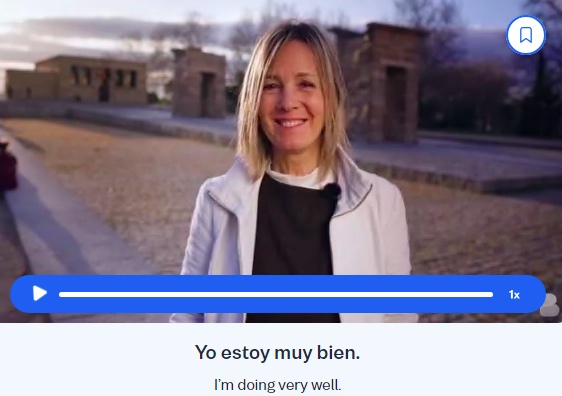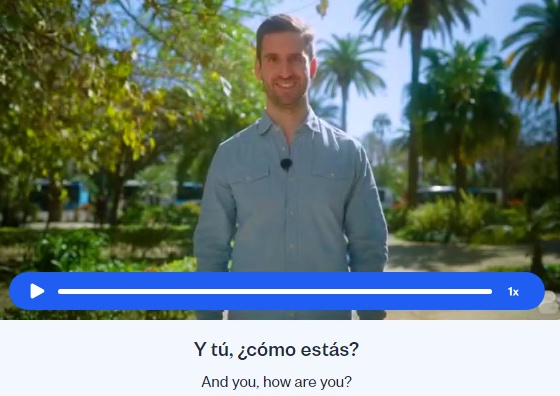Understanding the Spanish Verb Estar
Learn the present tense basics of this essential Spanish verb
I want to learn...
Imagine it’s summer and you’re lying down and enjoying the sun and warm weather outside. You’re happy, you’re calm, you’re content. How would you describe this temporary state of being? For that, we have the useful verb estar (to be) in Spanish.
Estar is an irregular Spanish verb and it means "to be". But be careful! There is another Spanish verb with the same meaning (ser). Estar has distinct uses and conjugation patterns, and we’ll explore them here with the help of some examples so that you can begin using it with confidence.
¡Vamos!
Let’s go!
The many uses of "estar"
There are two verbs for “to be” in Spanish: While ser focuses on permanent characteristics, estar is used to express temporary states.
Essentially, estar is used in four main ways:
1. Temporary states
Estar is used to describe a temporary state of being or feeling. If you are tired or sick, for example, you would use estar to get the message across. Locations
Use estar to talk about where a person, place, or object is. For example, if you are in the countryside or you left your keys on the table.
2. Conditions/Characteristics
When describing a condition that is temporary, such as a window being open or closed, or a characteristic of something, you use estar.
3. Feelings and emotions
Just as we can use estar to express physical states such as being sick or tired, we can also use it to explain our emotional states. If we are happy, sad, or excited, we use estar.
Let’s look at some examples of using estar in these ways:
Temporary states
Estoy cansado. (I am tired.) (temporary states)
Locations
Mis llaves están en la mesa. (My keys are on the table.)
Conditions / characteristics
La ventana está cerrada. (The window is closed.)
Feelings and emotions
Estoy contenta. (I am happy.)
Now that we’ve looked at the different contexts for using estar, let’s break down how to conjugate this important verb so that you can practice using it yourself.
How to conjugate estar in Spanish: Present tense
While it is helpful to know how to conjugate estar in many different tenses, we’re just going to focus on the present tense here.
Present tense conjugation: estar
| Subject Pronoun | Conjugation |
|---|---|
| yo | estoy |
| tú | estás |
| el / ella | está |
| usted | está |
| nosotros / nosotras | estamos |
| vosotros / vosotras | estáis |
| ellos /ellas / ustedes | están |
Note: Vosotros / vosotras is mainly used in Spain and not in Latin America, where they tend to use ustedes instead. Check out our article on the differences of Spanish used in Spain and Latin America.
Practice using different forms of“estar” in your daily conversations
You will learn that in the sentence "Y tú, ¿cómo estás?" (And you, how are you?), the verb "estás" is the second person singular form of the verb "estar" (to be) in Spanish. "Estás" specifically refers to the temporary or current state of being. Practice with Busuu’s free online Spanish courses and learning resources today!
Using estar in the present tense is a great way to talk about how people are feeling, whether that is yourself, a friend, or a group of people.
Here are some examples:
Estoy nervioso. (I am nervous.)
Nosotros estamos emocionados. (We are excited.)
¿Estás contenta? (Are you happy?)
Estar + an adjective
In the above examples, we see estar being used with an adjective. When we do this, it is important for us to pay attention to the subject pronoun and the adjective and make sure that they agree in both number and gender.
Take a look at the second example:
Nosotros estamos emocionados. (We are excited.)
Here, we add an “s” at the end of emocionado to make sure it matches with the plural subject pronoun nosotros.
In this example, we are either talking about a group of mixed males and females or a group of only males. But what if it was a group of only females? How could we write the sentence then?
Nosotras estamos emocionadas. (We are excited.)
This sentence matches both gender and number.
Your turn!
How would you say, “She is a little tired.”?
If you came up with "Ella está un poco cansada", then that’s correct! Nice work.
Estar + subject pronouns
With estar, as with virtually all Spanish verbs, it isn’t always necessary to use the subject pronoun when speaking. This is because Spanish conjugated verb forms indicate their subject pronoun it is for.
If we see estamos emocionadas (we are excited), for example, we know that the speaker is referring to nosotras (we) because of the way estar is conjugated in that sentence.
Interestingly enough, we also know that the subjects of the sentence were female. How? Because the -as on the end of emocionadas (excited) tells us that this is a group of women.
Dropping your subject pronouns when speaking is a great way to sound more natural, and it’s definitely something to practice and get comfortable with.
However, when you need to emphasize the subject or when it isn’t clear from the sentence, make sure that you are including your subject pronouns. Also, if you are speaking or writing formally, it’s best to include them as well.
A note on estar vs. ser
As we touched on at the beginning, estar is not the only Spanish verb used to express “to be”. Ser is also commonly used and is often mixed up by beginner Spanish speakers with estar. Let’s take a moment to clarify their usage and recognize when to use estar instead of ser.
We use ser to describe permanent characteristics such as occupation, nationality, physical appearance, or personality traits and qualities. We also use it to indicate time, days of the week, and dates along with ownership and origin.
For example, asking someone “Whose bike is this?” would require the verb ser: ¿De quién es esta bicicleta?
Based on what we have already covered about the different uses of estar, which of the following sentences do you think would use estar?
- I am really sick.
- It’s her house.
- I am in Dallas.
- We are at the park.
- You (plural) are so excited!
Which sentences did you choose for estar? If you chose 1, 3, 4, and 5, you are correct.
Let’s see what all five of these sentences look like in Spanish.
Estoy muy enfermo/a. (I am really sick.)
Es su casa. (It’s her house.) *Note the use of ser
Estoy en Dallas. (I am in Dallas.)
Estamos en el parque. (We are at the park.)
¡Están muy emocionados/as! (You (plural) are so excited!)
Did you notice the subject-verb agreement in these sentences? Did you also notice how subject pronouns were dropped?
¡Ahora estáis listos! Now, you are ready!
Now you know when to use the irregular verb estar (for temporary situations, describing states of being and emotions, locations, and conditions) and how to conjugate it using the present tense.
You’ve also understood that when using estar, you can often drop your subject pronouns as long as the context of the sentences allows.
With all this great information under your belt, you’re now ready to practice using estar in the present tense.
Great work!
Want to keep the momentum going?
Don't stop now! Continue with Busuu’s free online courses and vocabulary reviews, guaranteed to guide and help you along your way to Spanish fluency!

